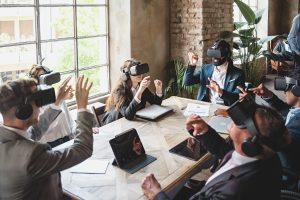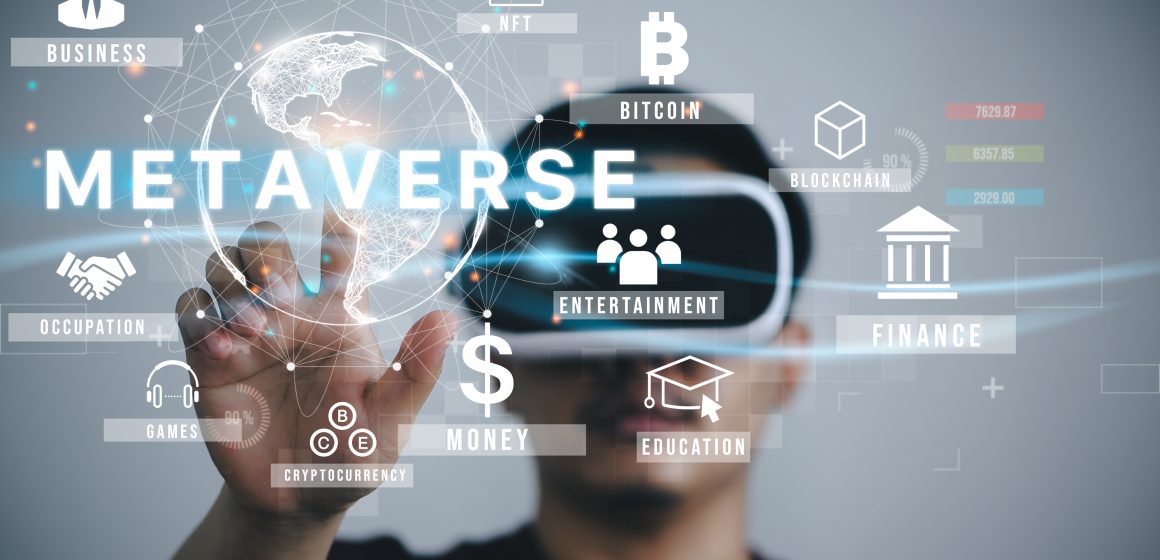A Metaverse is a virtual reality simulation that can be utilized for numerous purposes, from entertainment and social networking to education and business.
It is a 3D virtual environment built and maintained by users that can be explored and interacted with just like the physical world. It is a possible version of the internet as a universal, immersive, and socially focused virtual world.
Why is everyone so excited about the Metaverse?

There is a lot of buzz about the concept of the Metaverse. A significant portion of it is produced by technology companies that are anticipatorily claiming to be Metaverse companies or constructing Metaverses to enhance or augment the digital and physical worlds of people. In addition, activities that are currently carried out in separate contexts will eventually be consolidated into a single Metaverse, including the following:
Buying clothing and other items for use in creating digital avatars;
Purchasing virtual land and developing it with virtual dwellings;
Participating in a virtual social experience;
Using immersive commerce to go shopping in virtual shopping malls;
Creating an immersive learning experience through the use of virtual classrooms;
The purchase of digital works of art, collectibles, and valuables (NFTs)
Interacting with digital people for purposes such as hiring new staff, providing customer service, making sales, and handling various commercial transactions.
A metaverse would offer opportunities and business models that are persistent, decentralized, collaborative, and interoperable. These features will make it possible for enterprises to extend their digital operations.
What kind of commercial potential does the Metaverse present?
Numerous uses and products are available today, each of which generates its unique form of the Metaverse.
The learning experience can be more immersive in fields such as higher education, medicine, the military, and several types of trades. They won’t have to spend time or resources developing their infrastructure because the Metaverse will provide the framework.
The scope of retail can be expanded to include an immersive shopping experience, which paves the way for selling more complicated goods.
Through electronically augmented workspaces, businesses can reach higher levels of employee engagement, collaboration, and connection.
The social media future lies in the Metaverse, where users communicate using three-dimensional avatars. Because the implementation of Metaverse technology is still in its infancy and uneven, we advise against making significant financial investments in any particular Metaverse. It is still too early to identify which investments will be profitable over the long run. Instead, the focus should be on learning about, exploring, and preparing for a metaverse without going overboard with an implementation based on a few use cases.
1. Virtual Reality
It is an environment that simulates the users can explore using an avatar. The virtual environment shows the user’s perceptual data and real-time actions, conversations, and movements of other users.
MMOs employ virtual environments to let players construct and travel. Metaverse proponents believe virtual worlds can be used in collaboration software and medicine. Virtual worlds are termed “synthetic worlds.”
Virtual Reality is a simulated experience supplied by a headset that projects realistic pictures, sounds, and other sensations. Virtual Reality is utilized for video games but could be used for meetings, medical training, or military training. A person wearing virtual reality equipment can move about and interact with objects and other people.
3. Mixed Reality
Mixed Reality combines real and virtual worlds to provide new ways to engage with physical and digital locations and others.
Place-specific simulations such as 3D charts or concepts displayed on virtual reality headsets or glasses in a university lecture are examples of mixed Reality. Participants may see Pokemon they catch in the real world via their mobile device’s camera. Mixed Reality is used in video games, education, military training, healthcare, and human-robot interaction.
4. Augmented Reality
Augmented Reality creates an interactive approach to exploring real-world environments, like mixed Reality. Augmented Reality adds sights, audio, sensory, or olfactory data to the real world. Augmented Reality combines actual and virtual worlds with real-time interaction and 3D renderings of both. It could be used to let customers picture a product in their homes.
5. Cyber-economies
“Virtual economy” refers to the exchange or selling of virtual items in online games, especially MMOGs. In some games, players can buy items from each other using real money. Cryptocurrencies and non-fungible tokens can now be used in virtual economies. Many anticipate that social media companies and other organizations may launch their virtual currencies in the future, although regulators may prohibit them.
COMPANIES INVOLVED IN THE METAVERSE TECHNOLOGY
Several companies offer metaverse products or services or have said they will. They include the following.
1. Facebook/Meta Facebook (FB) changed its name to Meta Platforms in 2021 and spent substantially on metaverse experiences. It will use its stake in VR equipment maker Oculus.
Meta Platforms believes VR is the future of social media. Meta’s concept relies on speculative technology and server capacity. It anticipates the widespread use of VR headsets and innovative spectacles.
2. Microsoft is modifying existing technology for the Metaverse. Mesh, a mixed reality technology, lets users access augmented reality surroundings through their smartphone or laptop without VR equipment. Microsoft aims to integrate Microsoft Teams into the Metaverse for remote workers and virtual meetings.
3. Roblox (RBLX) creates virtual gaming experiences. Roblox is a teen-focused online gaming platform. The company wants to offer pornographic games.
4. Nvidia Corporation Nvidia Corp. (NVDA) is constructing an Omniverse platform to connect 3D virtual worlds in a shared universe and simulate buildings and factories.
5. Nike (NKE) is also making a metaverse play by registering digital trademarks for virtual Nike footwear and clothing and launching Nikeland on the Roblox platform, where gamers can play sports games.
6. Snapchat (SNAP) has created AR filters. Their photo filters allow phone camera manipulation. In 2021, they launched augmented reality glasses to enhance consumers’ outside-app experiences.
7. Second Life, a once-popular online MMO, lets participants live in a virtual environment. The San Francisco startup Linden Lab built the early metaverse experience, and users spent tokens on buying stuff in the game.
8. XboxEpic Games created Fortnite. The company started with video games but now produces virtual concerts and dance events.
9. Medical Education Medical learning firms use virtual and augmented Reality to simulate patient and surgical encounters and teach new procedures.






























LEAVE A COMMENT
You must be logged in to post a comment.